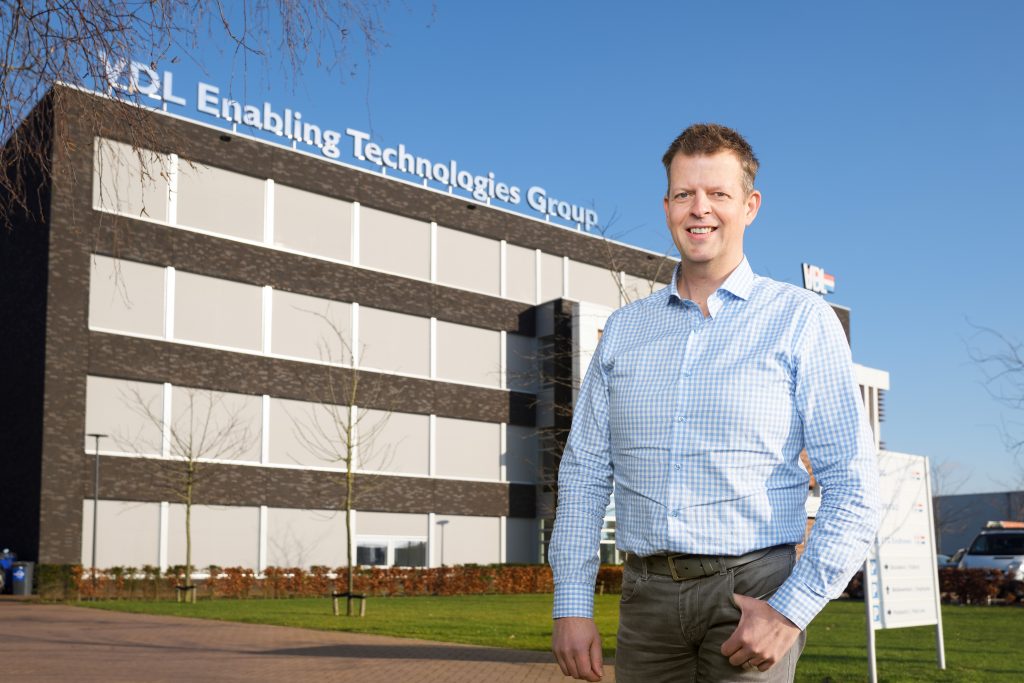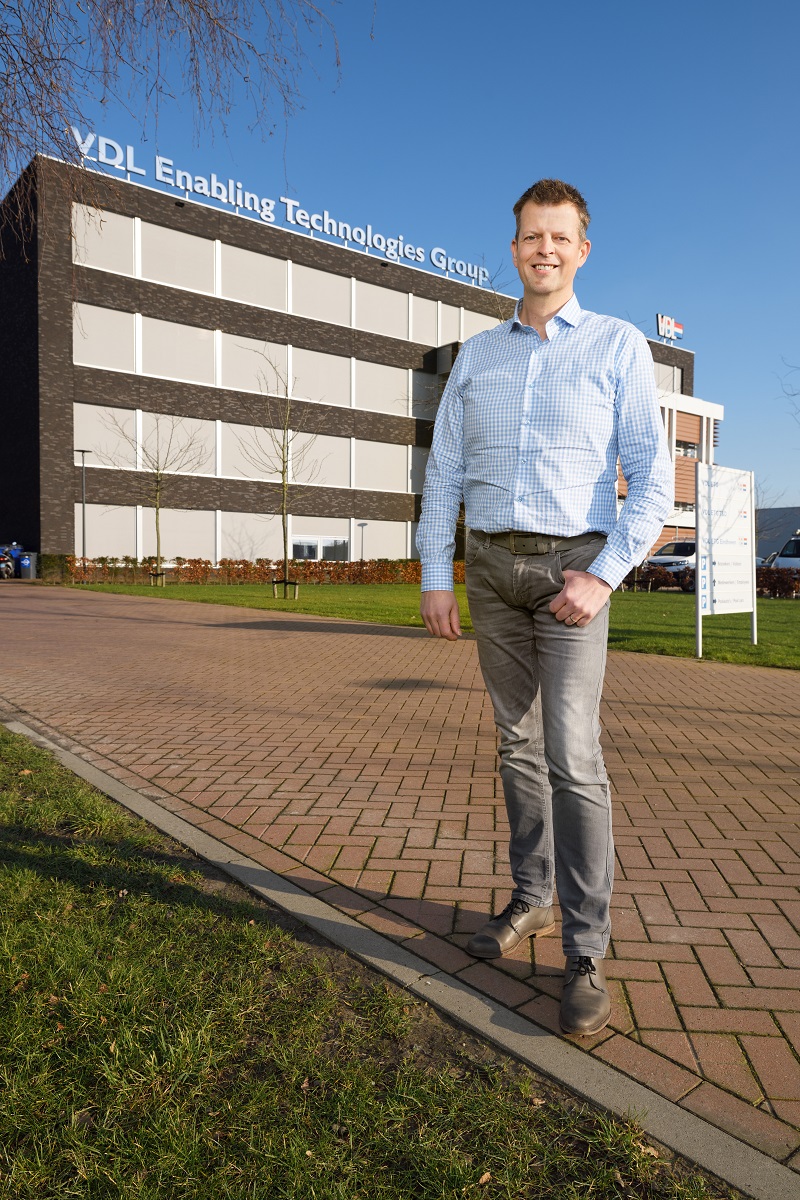Bart Schalken (VDL-ETG)
High-tech development processes are becoming so complex that organizations cannot avoid thinking and working in a multidisciplinary way. After all, the ideal solution is rarely one-dimensional. However, collaborating engineers from different fields are only successful if they understand each other’s jargon. VDL ETG T&D sends its technology professionals to the Mechatronics system design training at High Tech Institute so that they can train that skill.
The mechanical engineering group of VDL ETG’s Technology & Development department currently employs approximately fifty people, of eight different nationalities. Group leader Bart Schalken notices the differences: “Education in the Netherlands is excellent and the knowledge level is very high. You can only see that clearly when you start recruiting internationally. I grew up in Eindhoven, so in my experience, this is the normal world. However, when you talk to international engineers, you notice how special the technical level is in this region. In the field of precision mechanics, our schools and universities are ahead of their international counterparts.”
'Mechanics may often be the basis here, but that doesn’t mean that you can meet all system requirements.'
Another point where Dutch engineers excel is that they’ve learned to look beyond the boundaries of their own discipline. This quality is becoming increasingly crucial. “Development processes are almost all multidisciplinary and so complex that you can no longer approach them sequentially; you have to move in parallel,” says Schalken. “Mechanics may often be the basis here, but that doesn’t mean that you can meet all system requirements. Then it’s important to involve another discipline. Only by connecting and working together can you ensure that the product will meet the functional requirements.”

“You don’t have to know all the ins and outs of the other discipline, but you do have to master the basics,” says Bart Schalken of VDL ETG T&D. Credit: Bart van Overbeeke
But how do you find the right specialist within a group like Technology & Development that has grown from a few dozen to around three hundred and fifty since its inception eight years ago? To keep an overview and to ensure that everyone knows exactly who to contact, Schalken has carefully mapped out the sub-competences. “I’ve listed more than two hundred competencies and capabilities within mechanics and indicated per employee who has what knowledge. Those scores make it immediately clear who you should go to if you need knowledge about, for example, leaf spring constructions or vacuum systems,” Schalken explains. “Ultimately, the goal is to deliver the best result for our customers, but the know-how for the optimal solution doesn’t necessarily have to come from your project group or department. We make use of all the knowledge we have on board. And if there’s a hiatus, we always have our network of external partners and universities. That’s the atmosphere I want to create.”
Due to the increasing complexity and the urge for a shorter lead time, VDL ETG works with increasingly large project teams. “So the need for multidisciplinary collaboration is getting bigger and bigger,” Schalken experiences. “Normally, we’re in a large office space, but now, because of corona, we often work from home. That doesn’t make it any easier. Of course, we share the most important project information during digital meetings, but what’s missing now are the accidental conversations that arise at the coffee machine. While those are often the lubricant of smooth collaboration in projects.”
Eye-opener
A precondition for good collaboration is that engineers speak the same language. “You only seek each other out if you understand each other’s jargon,” says Schalken. “You don’t have to know all the ins and outs of the other discipline, but you do have to master the basics. Everything revolves around communication.”
To make the collaboration between the disciplines more effective and more decisive, at the beginning of last year, Schalken arranged for the High Tech Institute’s “Mechatronics system design” course to be given in-house at VDL ETG. Many of his people have now attended this training to gain a better understanding of adjacent disciplines. The course covers basic concepts and terminologies and the participants apply them to the disciplines around them.
“My group mainly consists of mechanical engineers, but such a course only really catches on when the other disciplines join as well. That’s why we invited people from the software, electronics and mechatronics groups. In addition to paying attention to theory, the training makes time to work together in teams pragmatically. That provides so much insight. Only when you look at a problem together, you really notice how they approach it from a different discipline. A real eye-opener.”
Although the follow-up process has been temporarily delayed due to the current corona measures, Schalken hopes that eventually most of his own group and as many engineers from other disciplines as possible will learn to speak the common engineering language. “In recent years, TU graduates have been given a broader base and have been trained to think and work in a multidisciplinary manner. For them, the Metron 1 training is no longer necessary and Metron 2 suits them better. That’s perfectly fine, of course – the great thing is that the added value is recognized,” Schalken states.
Start with the function
In addition to the training being an eye-opener for the participants, Schalken is counting on another advantage to become visible. “The core of VDL ETG is in system development, in combination with our manufacturing knowledge,” he explains. “Everything is under one roof. You can walk from the engineering department to the machining hall and the sheet metal shop. We have a lot of knowledge about manufacturability and value engineering. Helping and advising customers with DFX is where it all began. Today, VDL ETG itself is the development party and customers involve us starting from the specifications. We take care of the entire development process up to and including realization. As a result, customers only have one point of contact for the entire process.”

“Only when you look at a problem together, you really notice how they approach it from a different discipline.” Credit: Bart van Overbeeke
This approach means that VDL ETG engineers not only see the theory but are also closely involved in the manufacturing process, assembly and qualification of the end product. “The close connection between theory and practice ensures a steep learning curve for our engineers,” Schalken points out. “This knowledge is further enhanced because they get direct feedback on how the products are performing in the field. For example, we analyze parts that are returned after an update. Any weak links become visible and we take that knowledge with us to improve the next design.”
The mechanical engineers at VDL ETG focus a lot on DFX for series products in high-tech. “This knowledge is now well embedded within the organization,” says Schalken. “The next step is that we learn to think and work from the function of the system. What does the customer really want? What’s the question behind the question? And what roadmap is behind that?”
'The keys are communication and speaking the language of your colleagues from another discipline.'
Because VDL ETG has traditionally been quite focused on mechanical engineering – “our mechanical engineers are often the owner of a system” – the solution to a problem is quickly sought in that corner. “Ultimately, of course, you want to move towards a feasible and cost-efficient design – we’ve already laid that foundation – but the function of the design is the starting point,” Schalken states. “What does it take to make it happen? That’s the goal you must have in mind all the time. The mechatronic systems we develop focus on increasingly faster and more accurate positioning in an increasingly cleaner environment. What competencies do you need to realize such a position accuracy with those preconditions? You don’t have to come up with the solution yourself, but you must understand when to involve whom in the development to reach the end goal. The keys are communication and speaking the language of your colleagues from another discipline.”
This article is written by Alexander Pil, tech editor of Bits&Chips.
Recommendation by former participants
By the end of the training participants are asked to fill out an evaluation form. To the question: 'Would you recommend this training to others?' they responded with a 8.9 out of 10.

